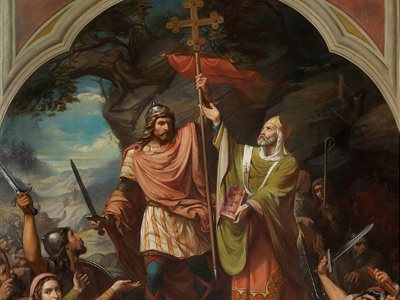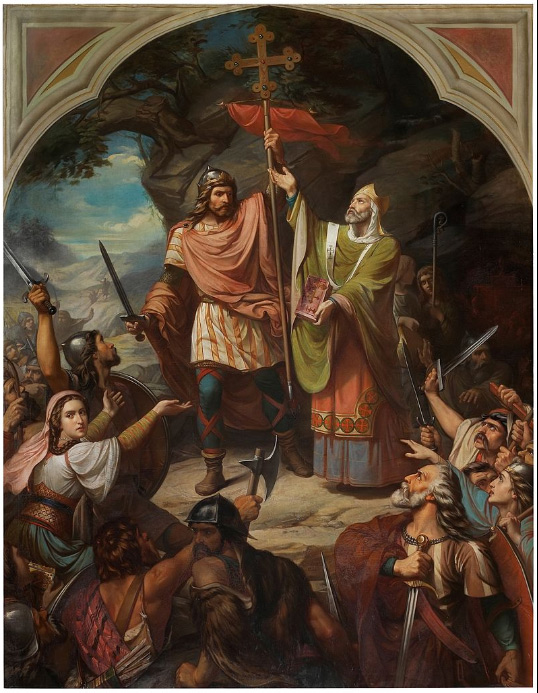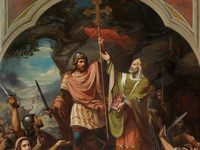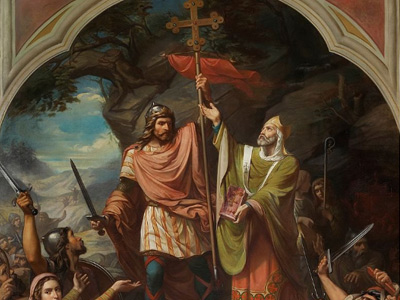Battle of Covadonga (722 AD)

The Battle of Covadonga was the first victory won by Christian military forces in Iberia after the Islamic conquest of Hispania in 711–718. It was fought at Covadonga, most likely in the summer of 722. The battle followed the creation in 718 of an independent Christian principality in the mountains of the northwestern region of the Iberian peninsula that grew into the Kingdom of Asturias and became a bastion of Christian resistance to the expansion of Muslim rule. As a result, the Battle of Covadonga has been credited by historians with catalyzing the Reconquista or the "reconquest" of Christian rule to the entire peninsula.
Prelude
According to texts written by Mozarabs in northern Iberia during the ninth century, the Visigoths in AD 718 elected a nobleman named Pelagius, (681–737), as their princeps, or leader. Pelagius (Don Pelayo in Spanish), the first monarch of the Asturian kingdom, was a grandson of a former King of Hispania, Chindasuinth, and son of Favila, who had been a dignitary at the court of the Visigoth King Egica (687–700), established his headquarters at Cangas de Onís, Asturias and incited an uprising against the Umayyad Muslims.
From the beginning of the Muslim invasion of Iberia, refugees and combatants from the south of the peninsula had been moving north to avoid Islamic authority. Some had taken refuge in the remote mountains of Asturias in the northwestern part of the Iberian peninsula. There, from among the dispossessed of the south, Pelagius recruited his band of fighters. His first acts were to refuse to pay the Jizya (tax on non-Muslims) to the Muslims any longer and to assault the small Umayyad garrisons that had been stationed in the area. Eventually, he managed to expel a provincial governor named Munuza from Asturias. He held the territory against a number of attempts to re-establish Muslim control, and soon founded the Kingdom of Asturias, which became a Christian stronghold against further Muslim expansion.
For the first few years, this rebellion posed no threat to the new masters of Hispania, whose seat of power had been established at Cordoba. Consequently, there was only a minor perfunctory reaction. Pelagius was not always able to keep the Muslims out of Asturias but neither could they defeat him, and as soon as the Moors left, he would always re-establish control. Islamic forces were focused on raiding Narbonne and Gaul, and there was a shortage of manpower for putting down an inconsequential insurrection in the mountains. Pelagius never attempted to force the issue, and it was an Umayyad defeat elsewhere that probably set the stage for the Battle of Covadonga. On July 9, 721, a Muslim force that had crossed the Pyrenees and invaded the Kingdom of the Franks was defeated by them in the Battle of Toulouse, in present-day France France, officially the French Republic is transcontinental country predominantly located in Western Europe and spanning overseas regions and territories in the Americas and the Atlantic, Pacific and Indian Oceans. France reached its political and military zenith in the early 19th century under Napoleon Bonaparte, subjugating much of continental Europe and establishing the First French Empire.. This was the first serious setback in the Muslim campaign in southwestern Europe. Reluctant to return to Cordoba with such unalloyed bad news, the Ummayad wāli, Anbasa ibn Suhaym Al-Kalbi, decided that putting down the rebellion in Asturias on his way home would afford his troops an easy victory and raise their flagging morale.
France, officially the French Republic is transcontinental country predominantly located in Western Europe and spanning overseas regions and territories in the Americas and the Atlantic, Pacific and Indian Oceans. France reached its political and military zenith in the early 19th century under Napoleon Bonaparte, subjugating much of continental Europe and establishing the First French Empire.. This was the first serious setback in the Muslim campaign in southwestern Europe. Reluctant to return to Cordoba with such unalloyed bad news, the Ummayad wāli, Anbasa ibn Suhaym Al-Kalbi, decided that putting down the rebellion in Asturias on his way home would afford his troops an easy victory and raise their flagging morale.
Battle
In 722, forces commanded by the Umayyad commanders Al Qama and Munuza, and (according to legend) accompanied by Bishop Oppas of Seville, were sent to Asturias. As Al Qama overran much of the region, folklore suggests that Oppas attempted to broker the surrender of his fellow Christians, but he failed in the effort. Pelagius and his force retreated deep into the mountains of Asturias, eventually retiring into a narrow valley flanked by mountains, which was easily defensible due to the impossibility of launching a broad-fronted attack. Pelagius may have had as few as three hundred men with him.

Al Qama eventually arrived at Covadonga, and sent forward an envoy to convince Pelagius to surrender. He refused, so Al Qama ordered his best troops into the valley to fight. The Asturians shot arrows and stones from the slopes of the mountains, and then, at the climactic moment, Pelagius personally led some of his soldiers out into the valley. They had been hiding in a cave, unseen by the Muslims. The Christian accounts of the battle claim that the slaughter among the Muslims was horrific, while Umayyad accounts describe it as a mere skirmish. Al Qama himself fell in the battle, and his soldiers withdrew from the battlefield.
In the aftermath of Pelagius' victory, the people of the conquered villages of Asturias now emerged with their weapons, and killed hundreds of Al Qama's retreating troops. Munuza, learning of the defeat, organized another force, and gathered what was left of the survivors of Covadonga. At some later date, he confronted Pelagius and his now greatly augmented force, near the modern town of Proaza. Again Pelagius won, and Munuza was killed in the fighting. And although the Arabs in their own histories called Pelagius and his men "thirty Infidels left, what can they do", they never again seriously challenged the independence of the Kingdom of Asturias. The battle is commemorated at the shrine of Our Lady of Covadonga.
HISTORY

RESOURCES
This article uses material from the Wikipedia article "Battle of Covadonga (722)", which is released under the Creative Commons Attribution-Share-Alike License 3.0.
© Stories Preschool. All Rights Reserved.









